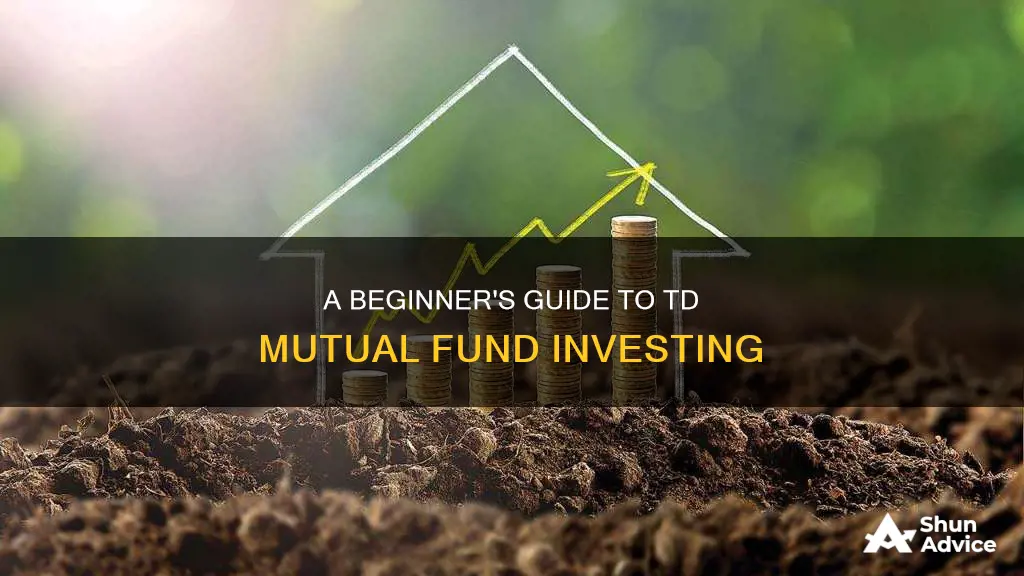
Investing in mutual funds is a great way to diversify your portfolio and reduce the risk of investing in a single security. Mutual funds are a collection of stocks, bonds or other securities held within a single fund, and they are managed by professional fund managers. TD offers a wide range of mutual funds with different investment goals, timelines, and risk profiles. In this article, we will discuss the steps to investing in mutual funds with TD, the types of mutual funds offered by TD, and the benefits and risks of investing in mutual funds. We will also explore how TD's mutual funds can help you achieve your financial goals and maximize your returns.
| Characteristics | Values |
|---|---|
| Type of investment vehicle | Pools money from various investors to invest in different assets |
| Investment types | Stocks, bonds, money market investments |
| Management | Professionally managed by fund managers |
| Initial investment amount | Small minimum investment amount |
| Trading | Traded once per day at closing Net Asset Value (NAV) |
| Distribution types | Capital gains, interest income, foreign source income, taxable dividends |
| Management Expense Ratio (MER) | Includes management fee, taxes, operating costs, trailing commission |
| Trailing commission | Paid to mutual fund dealer you bought from |
| Sales charges | Front-end load, back-end load |
| Redemption | Liquid assets that can be redeemed Mon-Fri between 9am-3pm EST |
What You'll Learn

Understand the costs of mutual funds
When investing in mutual funds, it is important to understand the associated costs. Mutual fund costs are typically expressed as a Management Expense Ratio (MER). The MER represents the fund's management fee and any other expenses, costs, or fees incurred by the fund. The MER is not charged to investors directly but is instead deducted from the returns of a fund.
The MER covers the costs of operating the fund, including portfolio management fees, taxes, and operating costs. These fees are paid to the fund manager to cover the day-to-day operations of the fund, such as research, regulatory compliance, investment, and professional management. The MER may vary depending on the type of fund and how actively it is managed. For example, index funds generally have lower MERs because they are passively managed, while actively managed funds tend to have higher MERs as they involve more active investment strategies and expertise.
In addition to the MER, some mutual funds may also charge sales commissions or loads. Front-end loads are charged when you purchase the mutual fund, while back-end loads are paid when you sell your share of the fund. It is important to note that when you purchase TD Mutual Funds through TD Investment Services Inc., you will not be charged any loads, and 100% of your investment goes towards the fund.
To encourage long-term investing, a short-term trading fee may be applied if you switch or redeem a fund too early. It is important to understand these fees and how they will impact your investment returns. Be sure to review the Fund Facts and Simplified Prospectus for detailed information about the mutual fund's costs.
Unlocking Tax Lien Investments: Funding Strategies Revealed
You may want to see also

Understand the benefits of mutual funds
Mutual funds are a popular investment choice, especially in the US, as they offer an efficient way to diversify your portfolio. They are a collection of stocks, bonds, cash, or other securities grouped together in one fund. They are managed by professionals who research and select securities and monitor the fund's performance. Here are some of the benefits of investing in mutual funds:
Diversification and Risk Reduction
Mutual funds provide access to a wide range of securities and markets, allowing you to diversify your portfolio without having to select individual stocks or bonds. By investing in multiple assets, mutual funds help to reduce the risk associated with investing in a single security.
Professional Management
Mutual funds are built and managed by professional money managers with extensive investment knowledge and expertise. They research investment opportunities, make day-to-day decisions, and monitor the fund's performance to help keep your investments on track.
Convenience and Fair Pricing
Mutual funds are convenient and easy to buy, sell, and understand. They typically have low minimum investment requirements and are traded once per day at the closing net asset value (NAV), eliminating price fluctuations throughout the day. Mutual funds also provide easy access to your money, allowing you to convert your assets to cash quickly.
Reinvestment Opportunities
Mutual funds allow for the automatic reinvestment of income earned by the fund. Dividends and interest income sources can be used to purchase additional shares in the mutual fund, helping your investment grow over time.
Tax Benefits
Mutual funds held within registered accounts, such as a Registered Retirement Savings Plan (RRSP) or Tax-Free Savings Account (TFSA), offer tax advantages. Profits earned within these accounts may not be taxed until withdrawn, or not taxed at all.
Other Benefits
Mutual funds can provide access to various investment styles, such as equity, fixed income, and asset allocation. They also offer lifestyle funds that let you choose and maintain the risk level that aligns with your financial goals and risk tolerance.
Mutual Funds: Risky Business and Poor Investment Choice
You may want to see also

How to choose the right fund for you
The right fund for you depends on a number of factors, including your investment timeline, risk profile, and financial goals. TD offers a variety of mutual funds designed to help meet your investing needs.
TD Growth Funds
TD Growth Funds involve a medium to high level of risk, with the potential for greater returns compared to other non-equity mutual funds. If you're investing for a long-term goal, such as retirement, or your child's university education, a TD Growth Fund may be a good choice.
TD Fixed Income Funds
TD Fixed Income Funds provide a fixed rate of return for a set period of time and are considered lower risk as they typically invest in high-quality bonds rather than equities. These funds aim to deliver strong returns for a low amount of risk as a medium to long-term investment. If you have a lower risk tolerance or a mid-term investment timeline, a TD Fixed Income Fund could help you work towards your goals.
TD Money Market Funds
If you have a short-term investment timeline, TD Money Market Funds could help to minimize risk and may provide a steady income through interest payments. These funds invest in high-quality money market securities, which generally mature in less than a year, making them a low-risk short-term investment.
TD Balanced Funds
If you want a balanced approach to investing, striving for competitive returns with low to medium risk, TD Balanced Funds might be the right choice. These funds seek to provide a consistent monthly income, with investment growth as a secondary objective.
Other factors to consider
When choosing a mutual fund, it's important to review the fund's past performance, although it doesn't guarantee future success. You should also understand the costs associated with mutual funds, such as the Management Expense Ratio (MER) and any sales commissions or loads. Additionally, consider the level of diversification you want, as mutual funds can invest in multiple securities, markets, and sectors to reduce risk. Finally, evaluate your risk tolerance and investment goals to determine the right type of fund for you.
Best Vanguard Funds for Your Taxable Investment Portfolio
You may want to see also

How to start investing in mutual funds
Mutual funds are a great way to invest in a diversified portfolio of assets. They are also affordable and allow you to benefit from the expertise of experienced investment professionals. Here is a step-by-step guide on how to start investing in mutual funds:
Step 1: Understand Your Investment Goals
First, set some investment goals. Are you working towards short-term goals like saving for a down payment or long-term goals like retirement? Consider how much money you want to earn, how much you can afford to invest, and how much time you have to reach your goals.
Step 2: Evaluate Your Risk Tolerance
Next, think about how much risk you are willing to take. If you are worried about losing money, you may prefer lower-risk investments that pay lower returns. If you are willing to risk short-term losses, you may want to invest in higher-risk funds that offer higher potential returns.
Step 3: Research Different Types of Funds
Mutual funds come in various shapes and sizes. Some funds include investments from specific markets or industries, while others are more diversified. The right mutual funds for you will depend on your risk tolerance and investment goals. The more research you do, the more confident you will feel about your investments.
Step 4: Choose a Fund and Open an Account
Once you have researched the different types of funds, choose a fund that suits your financial goals and risk tolerance. You can then open an account with a financial institution, such as TD Direct Investing, to get started.
Step 5: Decide on an Investment Amount
Decide how much you are willing and able to invest. Some mutual funds require a minimum initial investment, while others do not. There is no right or wrong amount to choose, it depends on your personal budget. You can also make recurring contributions through a Systematic Investment Program (SIP).
Step 6: Start Investing and Invest Regularly
Now that you have chosen a fund and decided on an investment amount, it is time to start investing. You can buy mutual funds online, in-person, over the phone, or through a mobile app. Consider investing regularly to grow your investment and reduce the risk of buying a large number of mutual fund shares when prices are high.
Step 7: Perform Regular Check-Ins
Keep an eye on your investments and conduct occasional check-ins to ensure they are performing as expected. It is a good idea to review your portfolio annually and make any necessary adjustments.
Invest Wisely: Kotak Select Focus Fund Guide
You may want to see also

How to monitor your investments
Monitoring your investments is an important part of investing in mutual funds. Here are some ways you can monitor your investments in TD Mutual Funds:
- Review your portfolio regularly: Financial experts recommend reviewing your portfolio at least once a year to ensure it is performing as expected and make any necessary adjustments. This review can include checking the performance of individual mutual funds and the overall portfolio's diversification and risk exposure.
- Understand the costs and fees: Mutual funds have associated management fees and expenses that can impact the overall performance of your investments. Be sure to understand the Management Expense Ratio (MER) and any other fees, such as sales commissions or loads, to make informed decisions.
- Monitor market trends and news: Stay informed about market trends, economic conditions, and news related to your investments. This can help you identify potential risks or opportunities that may impact your mutual fund investments.
- Utilize TD's resources: TD provides various resources to help you monitor your investments. You can access your TD Mutual Funds account through the "My Accounts" - "View Accounts" or "My Accounts" - "Investing" screens on their website. This allows you to view Account Details, including holdings, account activity, and investment information such as units held, price per unit, market value, and average cost.
- Seek guidance from TD representatives: TD Mutual Fund Representatives are available to help you monitor your investments and provide guidance. They can assist in reviewing your portfolio, assessing risk, and making adjustments to align with your financial goals.
- Evaluate performance against goals: Regularly assess the performance of your mutual fund investments against your financial goals. This includes reviewing the returns generated, risk exposure, and progress towards your short-term and long-term objectives.
- Consider automated investment plans: TD offers automated investment plans, such as the Pre-Authorized Purchase Plan, which allows you to contribute to your mutual fund investments regularly. This can help you benefit from dollar-cost averaging, potentially lowering your average unit cost over time.
- Diversify your portfolio: Diversification is an important strategy to manage risk and maximise returns. Consider investing in different types of mutual funds, such as those focusing on various industries, sectors, or geographic regions. This can help reduce the impact of fluctuations in any single market or sector.
- Long-term investment horizon: Maintaining a long-term investment horizon can help reduce risk and improve the potential for higher returns. Market fluctuations can be smoothed out over longer periods, and staying invested for the long term can take advantage of compound interest and market growth.
A Guide to Investing in Calvert Funds Wisely
You may want to see also







